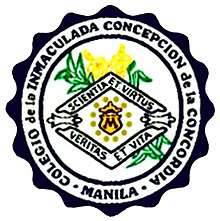Concordia College (Manila)
|
Colegio de la Inmaculada Concepcion de la Concordia | |
 Logo of the School | |
| Motto | Vita, Veritas, Virtus, Sciencia |
|---|---|
Motto in English | "Life, Truth, Virtue, Knowledge" |
| Type | Private Catholic school |
| Established | May 3, 1868 |
| Founder | Doña Margarita Roxas De Ayala |
Religious affiliation | Roman Catholic (Vincentian) |
| Principal | Sr. Nicetas M. Favorito, DC = 14°34′53″N 121°00′09″E / 14.581251°N 121.002525°ECoordinates: 14°34′53″N 121°00′09″E / 14.581251°N 121.002525°E |
| Address | 1739 Pedro Gil Street, Paco, Manila, Philippines |
| Hymn | College Hymn |
| Colors | Blue and White |
| Nickname | Concordian |
| Affiliations | U-Belt |
| Website | http://www.laconcordia.edu.ph |
The Colegio de la Inmaculada Concepcion de la Concordia (College of the Immaculate Conception of Concordia), simply Concordia College, is a Catholic private institution of learning in Pedro Gil, Paco, Manila, in the Philippines. The college was founded in 1868 and is run by Daughters of Charity of Saint Vincent de Paul. Concordia College prospered towards the end of the nineteenth century with an upward enrollment.
Etymology
Name
According to the Student Manual, the name "Concordia" means "in accord with" or "in accordance to the above"
Logo
White Easter Lily
Stands for purity in thought, word, and deed
Letter M and Crown
Stands for Mary, a figure in the Catholic religion, who is the patroness of the school. The crown which adorns the top of the letter represents her queenship of heaven.
Twelve Stars
The twelve stars which surround symbolize the twelve apostles, which represent the disciples as a whole. "It shows Mary's role in leading people to her son, Jesus"
The Colors
Blue and white are the colors which represent Mary. Blue stands for loyalty and white for purity or chastity.
Green stands for perpetual growth. Symbolizing the school that copes with the best and worst of times.
History
Colegio de la Inmaculada Concepcion de la Concordia was established by Doña Margarita Roxas de Ayala by converting her three-and-a-half hectare villa, the La Concordia Estate in Paco, Manila, into a school. She requested eight Daughters of Charity from Spain to come to the Philippines to manage the school. They arrived on May 3, 1868 and managed the free school or 'Escuela Pia'. Sixty students learned about religion, good manners, reading and writing, simple arithmetic, culture, and arts like sewing, embroidery, cooking, needlecraft and household work. The medium of the instruction was Spanish.[1]
In 1868, the school officially adapted a new name, Colegio de la Inmaculada Concepcion de la Concordia, in the same year that it became the Central House of the Daughters of Charity in the Philippines.[2]
Significant periods in the development of the Concordia College, such as the Philippine Revolution of 1896 and the American era, brought about education reform.
Academic programs
Basic Education Department
- K to 12
- Music courses: Piano, Voice, Guitar, Violin, and Drum Lesson
Higher Education Department
- Bachelor of Arts (AB)
majors: English Educational Technology
- Bachelor of Elementary Education (BEED)
majors: English Educational Technology
- Bachelor of Secondary Education (BSE)
majors: English Educational Technology
- Bachelor of Science in Social Work (BSSW)
- Bachelor of Science in Nursing (BSN)
- Bachelor of Science in Business Administration (BSBA)
majors: Marketing Management Human Resource Development Management Business Technology
- Master of Science in Nursing (MSN)
majors: Medical — Surgical Nursing Psychiatric Nursing in Maternal and Child Nursing Administration
- Master of Arts in Education (MAED)
majors: Educational Technology Business Administration
- Diploma in Junior Secretarial (DJS)
- Diploma in Junior Secretarial — Medical (DJS-MED)
- Associate in Health Science Education (AHSE)
- Alternative Learning System (ALS) Acceleration & Equivalent (A&E) Academic Focus Bridging Program (AFB) Continuing Learning Delivery System (CLDS)
Notable alumni
Among its well-known students was Maria Paz Mendoza-Guazon, the first Filipino woman doctor, who was also an educator, a writer and a feminist. Although her studies were interrupted by the Revolution, she was able to resume them when she transferred to the American School in 1901.
Other notable students were Saturmina, Soledad, and Olympia Rizal (sisters of Philippine national hero Jose Rizal; The college is mentioned in Rizal's novel Noli Me Tángere).
Gallery
 Facade
Facade Monument in front of the school
Monument in front of the school Historical marker
Historical marker U-shaped building
U-shaped building
References
- ↑ "About La Concordia College". Concordia College. Retrieved 9 April 2015.
- ↑ "About La Concordia College". Facebook. Retrieved 9 April 2015.